Stone, minerals and semiprecious of the world stone
Epidotes (silicates): Tourmaline -->rus
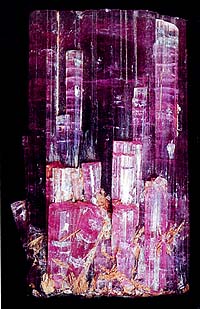 Diagnostic cart.
Diagnostic cart.
On a photo. Crystal of tourmaline. A mineral can be painted in a different color (in accordance with the name of difference). Look of crystals usually prismatic.
XY3 Z6 (BO3)3 Si6O18
Crystal structure trigonal
Hardness on the Mohs scale 7-7,5
Specific unit weight mass 3,02-3,36
Cleavage non-existent
Fracture, break padman, wrong, fragile frail brittle
Colors colourless, polycoloured (multicoloured)
Colors in powder triturate white
Glance (glitter, glare) glassy
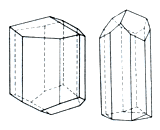
The name "Tourmaline" designates the group of trigonal borosilicates with a general formula, resulted higher. Depending on a value Х (Sa, Na, K), Y (AI, Fe2+, Fe3+, Zi, Mg, Mn2*) and Z (AI, Cr, Fe3+, V3+) is selected independent kinds: Elbaite, Schorl, Dravite (Tourmaline) and other None jewels color stones differs such variety of flowers, as Tourmaline. A although in Mediterranean he was known from ancient times, to Europe of Tourmaline Dutchmen left from Ceylon in 1703. They named his cingalese word "Tourmali".
Chemical composition (chemistry, compound) - inconstant; varies depending on the geochemical terms of formation. The admixtures of titan are marked, chrome, vanadium, tin and other of Crystal structure - trigonal, ditrigonal-dipyramid, bipyramid type of symmetry. Cleavage - non-existent, sometimes not clear to on (1120) and (1011). Any of a group of hard glassy minerals of variable colour consisting of complex borosilicates of aluminium with quantities of lithium, sodium, calcium, potassium, iron, and magnesium in hexagonal crystalline form: used in optical and electrical equipment and in jewellery.
Tourmaline Schorl - darkly-brown to resin-black; Dravite (Tourmaline) - yellow, gold, orange to brown; Elbaite - colourless (achroite), blue to intense-blue (Indigolite), green to rifle-green (Verdelite), pink, rose, red (Rubellite), often polychromatic; tsilazaite - pink, rose, raspberry.
Tourmaline forms the prismatic strongly extended crystals (long to a few centimetres) which are both-side completed verges; crystals are either short and thick or thin and little, as needles. Sometimes there are aggregates - parallel-pole and radiant-pole, and grains of wrong form. Vertical verges of crystal often streaked parallell to lengthening.
Colouring depends on chemical composition and extraordinarily changeable - is rose, red, light-yellow, azure sky-blue, green, light-brown and black. Often there are also colourless and varicoloured tourmalines, when colors are disposed as concentric areas or colouring changes along lengthening of crystal.
If to warm the crystal of tourmaline or squeeze it or scuff, there is an electric charge in him; thus one end of crystal revives positively, and other - negatively. Such electrified crystal attracts the particles of dust and shallow pieces of paper (pyro- and piezoelectricity).
The Dutch sea-folk and merchants, first bringing this mineral to Europe, knew and used this effect. They cleaned the meerschaum pipe tubes by the heated crystals of tourmaline, and that is why named it stone "Achencier" - drawing out an ash. Word "Tourmali", giving the modern name a mineral, in language of Singhale has that sense.
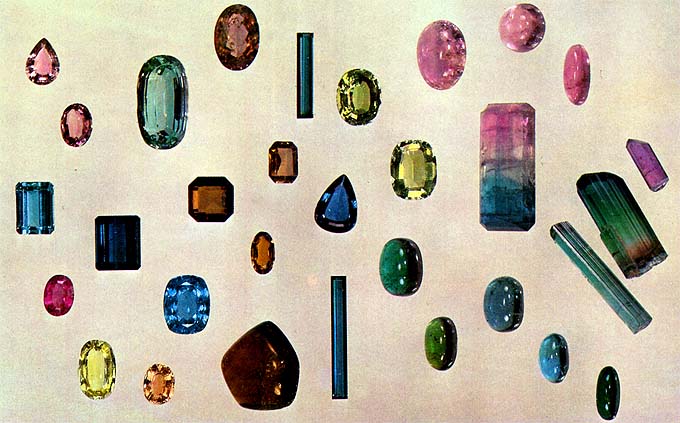
Origin provenance genesis.
Tourmalines are minerals pneumatolysis origins genesis, dissipated in rocks, enriched a silica, in particular, in granites and vein, lode, mine formations of aplite (a light-coloured fine-grained acid igneous rock with a sugary texture, consisting of quartz and feldspars) and pegmatitic types. They quite often meet in crystalline slates, in contact-metamorphic rocks, and also in deposited rocks.
Jeweller tourmalines appear in pegmatites. Industrial deposits are known and in mineral deposits. Most productive from them are on Sri Lanka and Madagascar, and also in Brazil (state of Minas-Zherays, Baiya). Mozambique supplies with good red and polychromatic stone to the market. Less considerable deposits are present also in Angola, Australia, Burma, India, Zimbabwe, Republic of South Africa, Tanzania, Thailand, CIS (Ural, Transbaikalia (Zabaykale)), USA (state of Californium, Maine, Colorado). In Europe collectors find tourmalines on an island Elba and in Switzerland (canton Tessin).
Deposit minefield mine field occurrence subsoil.
Very beautiful varicoloured crystals acted from pegmatites of Madagascar. Wonderful clean crystals are obtained in Fallen, state of Californium, in the Brazilian state of Minas-Zherays, from the mineral deposits of jewels of Sri Lanka and Ural (Russia, CIS). In Italy as Druses found out excellent varicoloured crystals in the granites of island Elba. In pegmatites they meet also among the pegmatitic rocks of Kravedzhiya and Kandolya in Ossole (province of Verbaniya), Oliaske on the lake of Komo and other alpine localities.
Use, practical application, deployment.
Except for the jeweller use of Tourmaline, possessing piezoelectric properties, used in a technique for measurings of high tensions and determination of frequency and tension of electric vibrations. Entangling tourmalines at riches of their colourings is possible with very much by many jeweller stone and foremost with Amethyst, by an andalusite, chrysoberyl, citrine, Demantoide , hiddenite, peridotite (by a chrysolite), praseolite, smoke-coloured quartz, ruby, emerald, synthetic green spinel, by a vesuvianite, zircon. There are imitations from glass. Strong pleochroism and high birefringence serve as base diagnostic signs of tourmaline.
Use is on jeweller business.
Varicoloured Tourmaline can be exposed to the various forms of cutting, at a preference either rectangular or oval or rounded. Now and then apply the form of cabochons either for tourmalines with plenty of including or in an order to expose the phenomenon of iridescent luminescence. Tourmaline - transparent jewels color stones, since olden times known and widespread in the whole world.
Rose, red and green tourmalines are most valued. Types of their cutting can be different. From strong pleochroism dark crystals cut so that the table of the cut stone was disposed parallell to their long ax. At light crystals it is oriented athwart to the main ax, to attain the maximal depth of color. At heating there is an ennoblement of colouring to 450-650oC: green tourmalines acquire an emerald tint, and brownish-red - bright-pink, rose. Artificial tourmalines do not exist.
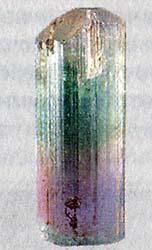
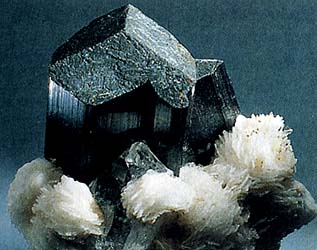
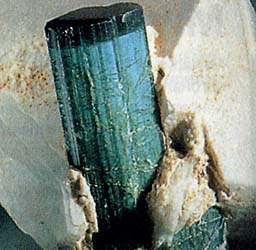
Tourmaline: Elbaite
Na(Li,Al) 3Al6(OH) 4(BO3) 3Si6O18. Be found as short prismatic crystals with the vertical shading, and also as dense the masses. Colouring is changeable, zonal, with transitions from yellow to green, blue, rose; now and then is white. Widespread in granit pegmatites, associated with a lepidolite, quartz and feldspars. In Italy there is Elba on an island as the extended crystals, at bottom base painted in a brown color which is after replaced green; at a top mineral is done colourless.
Tourmaline: Schorl
Na(Fe,Mn) 3Al6(OH) 4(BO3) 3Si6O18. The presence of iron gives this tourmaline a black color. Crystals are short-prismatic, completed verges pyramids. Glance (glitter, glare) metallic. Found out the magnificent crystals of schorl in Innietkhare (Western Australia). Other black variety of tourmaline, rich in magnesium, - twined. Him found out the perfectly formed crystals in Per-Poynt, in the state New York (USA).
Tourmaline: Indigolite
Na(Li,Аl) 3Аl6(HE) 4(Vo3) Si6О18 with Fe. Examined as a variety of Elbaite. Indigolite occupies the dark blue area of spectrum, from the easiest, cleanest tints inconspicuous-голубого to the deep indigo. Colors changes from sky-blue to lightblue, sometimes with a green tint. Ablaze, enough rare Tourmaline, considered most valuable. Other very popular Tourmaline - Rubellite. It by mistake is named the "Siberian ruby", both on the red colouring and because considered at one time, that he met only in Siberia. Colors rose and violet.
Tourmaline: Dravite (Tourmaline)
NaMg3Al6(OH) 4(BO3) 3Si6O18. Be found as prismatic crystals with the vertical shading, and also as dense the masses. Colouring is brown, black-brown, black; brilliance of glassy. It is mainly in metamorphic rocks, and also in pegmatites and basic orthorocks. A mineral got the name to down the river to Drave, to crossing Karintiyu, that region, where found his interesting copies. Discovered also in many places in the West of the USA.


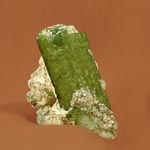

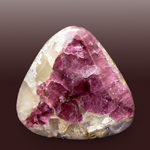

Tourmaline (zonal crystals). Madagascar. Munich-show-2007. A photo: © A.A. Evseev.
